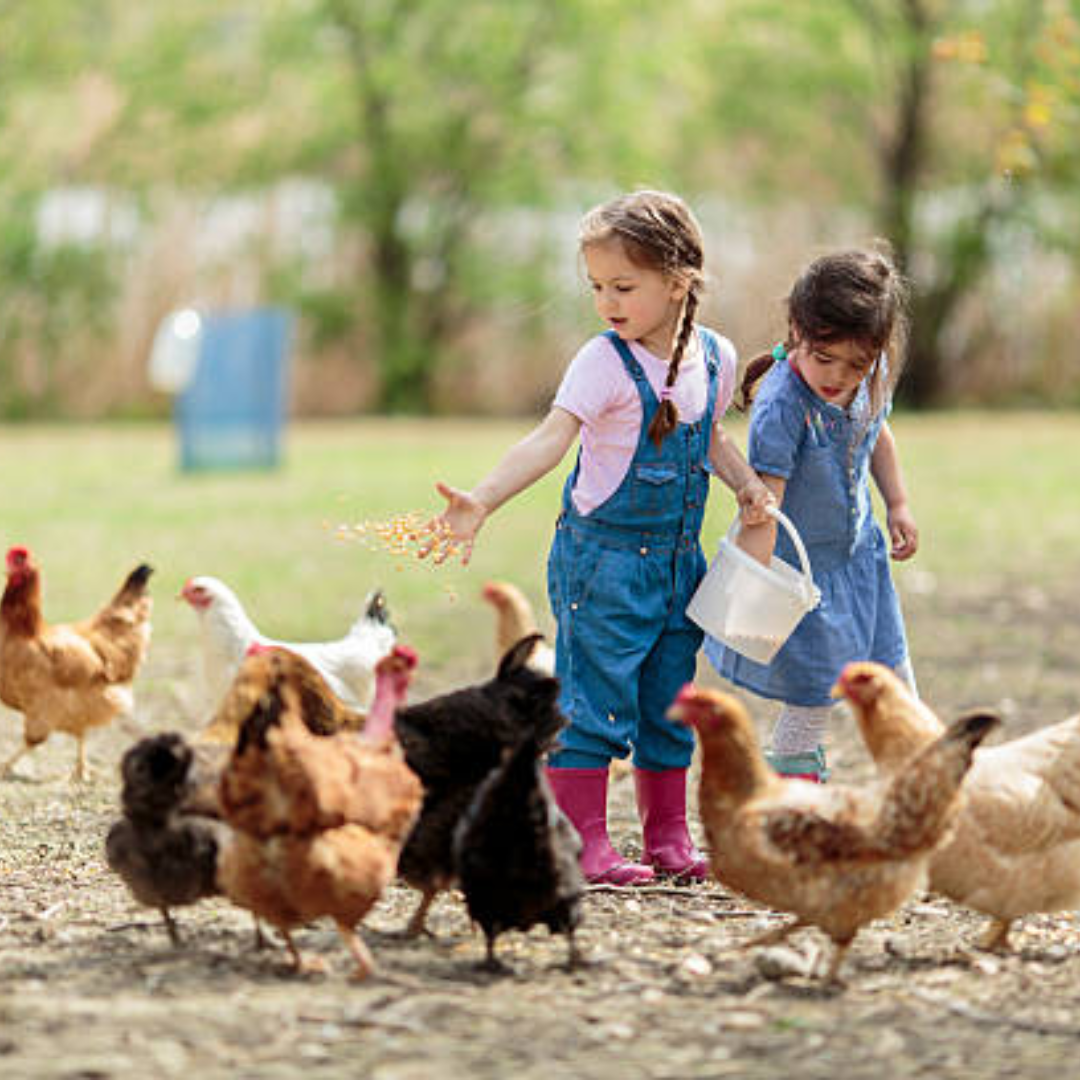Discover how to involve your children in daily farm life with homesteading with kids. Practical tips, fun activities, and life skills that make self-sufficiency a family adventure.
Have you ever dreamed of raising your kids in a simpler, more self-sufficient way? Homesteading with children might just be the adventure your family needs. It’s not about going completely off-grid or becoming expert farmers overnight. Instead, it’s about embracing a lifestyle that brings your family closer to nature, teaches valuable skills, and creates lasting memories.
As a mom who’s been homesteading with my own children in different ways throughout the years, I can tell you it’s been a wild and wonderful journey. From the joy on my son’s face when he harvested his first carrot to my son’s proud grin after picking fresh fruit from the backyard, these moments are priceless. But I’ll be honest – it’s not always picture-perfect. There have been muddy messes, stubborn animals, and more than a few gardening mishaps along the way.
In this post, I’ll explore how to make homesteading a family affair. I’ll share practical tips on preparing your homestead for kid-friendly activities, getting children involved in gardening and animal care, and even incorporating homesteading into homeschooling. I’ll also cover important topics like safety and age-appropriate tasks. So, whether you’re a seasoned homesteader or just starting out, let’s discuss the wonderful ways homesteading with kids can be!
This is a pinnable post. Tap or hover over any image in this post to pin to your Pinterest Boards.
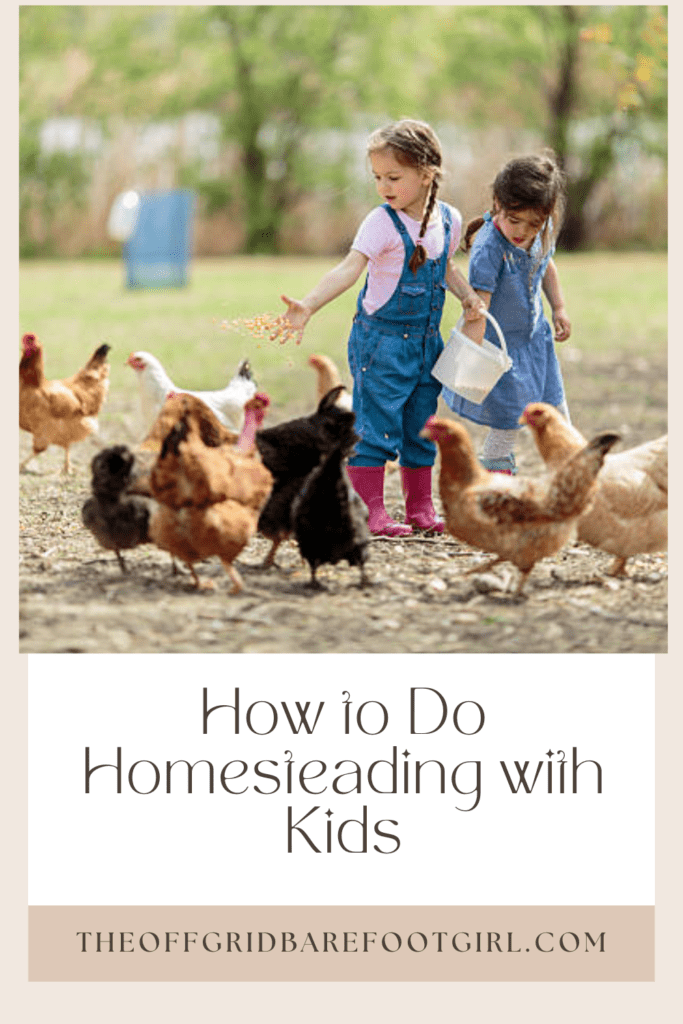
Understanding Homesteading and Its Benefits for Families
Homesteading is more than just a lifestyle; it’s a journey of self-sufficiency and connection to the land that can be incredibly rewarding for families. At its core, homesteading is about producing and preserving your own food, crafting household items, and living more sustainably. For families with children, it offers a unique opportunity to instill valuable life skills and create lasting memories.
One of the primary benefits of homesteading for families is the chance to work together towards common goals. Whether it’s planting a garden, tending to animals, or preserving the harvest, these activities foster teamwork and a sense of shared purpose. Children learn responsibility by caring for plants and animals, and they gain a deep understanding of where their food comes from.
Education in Practical Skills
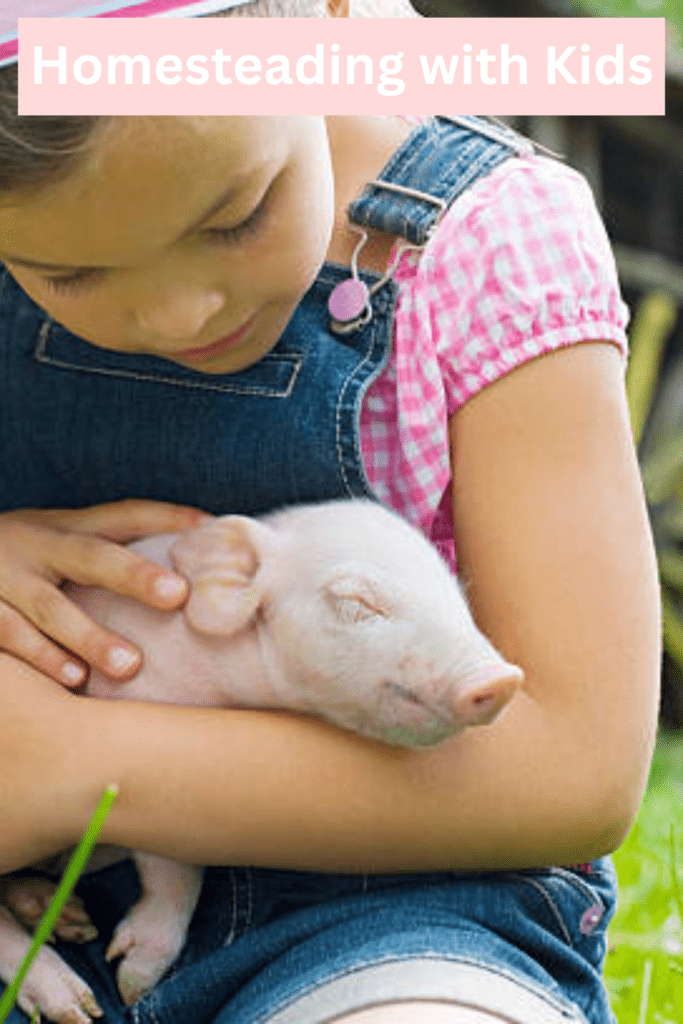
Homesteading also provides an excellent education in practical skills. Kids can learn about:
- Gardening and plant science.
- Animal husbandry.
- Food preservation techniques include canning and dehydrating.
- Basic carpentry and DIY skills.
- Resource management and conservation.
These hands-on experiences often reinforce academic concepts in math, science, and economics in a real-world context.
Another significant advantage is the connection to nature that homesteading cultivates. In our increasingly digital world, homesteading offers children the chance to unplug and engage with the natural environment. This can lead to improved physical health through outdoor activity and a greater appreciation for the ecosystem we’re part of.
Financially, homesteading can teach valuable lessons about budgeting, resourcefulness, and the value of hard work. As families work to produce their own food and goods, children learn about the effort that goes into creating the things we often take for granted. This can foster a sense of gratitude and mindfulness about consumption.
Also, homesteading often leads to a healthier lifestyle. Home-grown produce and farm-fresh eggs are just the beginning. The physical activity involved in maintaining a homestead can improve fitness levels for the whole family. Plus, there’s nothing quite like the satisfaction of sitting down to a meal you’ve grown and prepared yourself.
While homesteading with kids can be challenging at times, the benefits far outweigh the difficulties. It’s a lifestyle that not only prepares children for a self-sufficient future but also strengthens family bonds through shared experiences and accomplishments. As you begin on this journey, remember that every small step towards self-sufficiency is a victory, and the skills and memories you create along the way are priceless.
Preparing Your Homestead for Kid-Friendly Activities
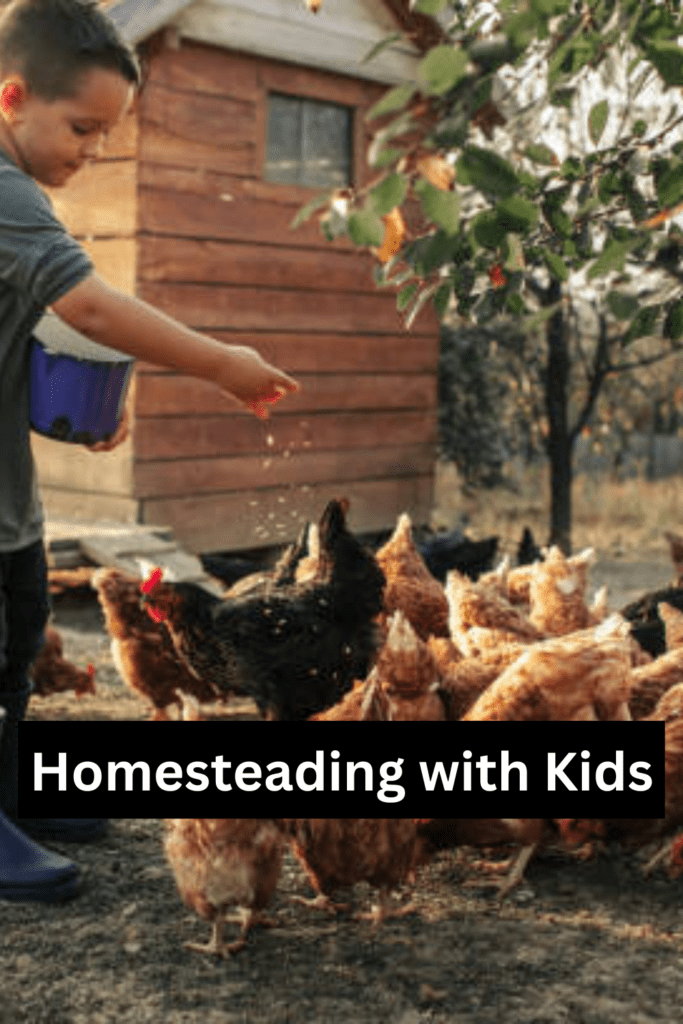
Creating a kid-friendly homestead is an exciting journey that allows you to share your love for self-sufficiency with the next generation. As someone who’s spent years cultivating my own homemade paradise, I’ve learned that preparing your homestead for children requires a blend of safety, education, and fun.
First and foremost, safety should be your top priority. Take a walk around your property and identify potential hazards. Secure any dangerous tools, equipment, or chemicals out of reach. If you have a pond or water feature, consider fencing it off. For younger children, create designated play areas away from any farm animals or active work zones.
Next, think about how you can make your homestead educational and engaging for kids. Set up a small garden plot just for them, where they can plant, tend, and harvest their own vegetables. This hands-on experience teaches responsibility and the joy of growing food. Consider adding a compost bin nearby and explain the cycle of nutrients – it’s a great way to introduce environmental concepts.
For animal lovers, create safe interaction zones with gentle farm animals like chickens or rabbits. Teach children how to approach and handle animals respectfully, and involve them in daily care routines. This not only fosters a love for animals but also instills a sense of responsibility.
Make it Fun! Homesteading with Kids
Don’t forget to incorporate fun into your homestead activities. Set up a nature scavenger hunt with items found around your property, or create an obstacle course using hay bales and old tires. A treehouse or a simple rope swing can provide hours of entertainment while connecting kids with nature.
For rainy days or downtime, designate an indoor area for crafts using natural materials found on your homestead. Pressing flowers, making leaf rubbings, or crafting with wool are all great options that tie into the homesteading lifestyle.
Remember that homesteading with kids is about balance. While it’s important to teach self-reliance and hard work, make sure there’s plenty of time for play and exploration. Let them get their hands dirty, ask questions, and discover the wonders of your homestead at their own pace.
By preparing your homestead with these kid-friendly activities in mind, you’re not just creating a safe and fun environment – you’re laying the foundation for a lifelong appreciation of sustainable living and the natural world. It’s a journey we can all admire together.
Engaging Kids in Garden and Crop Management: Homesteading with Kids
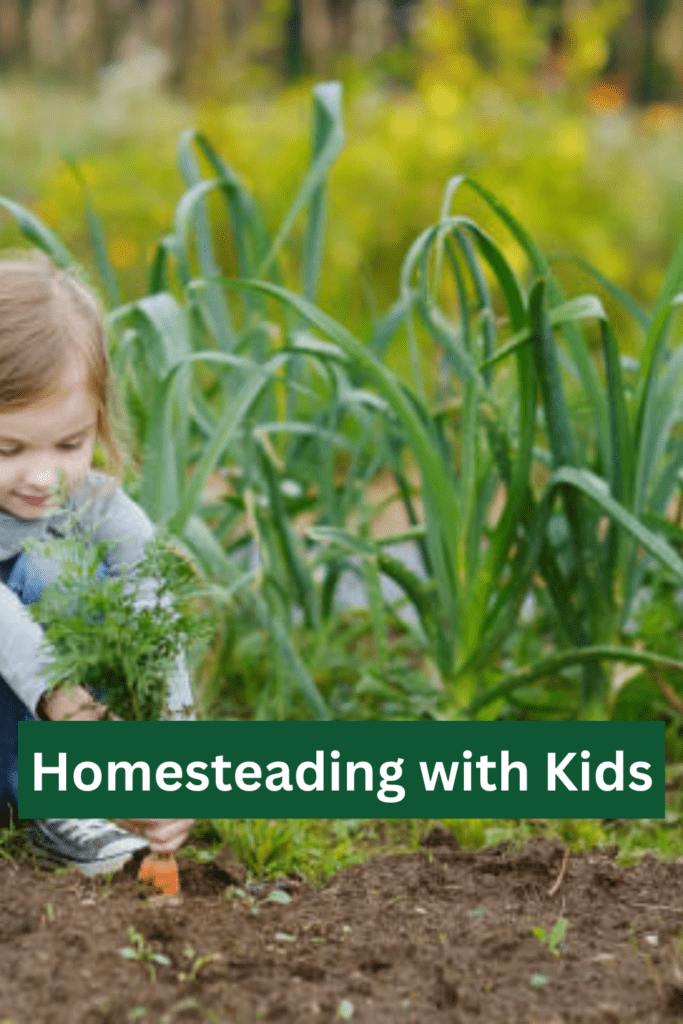
Gardening and crop management are essential skills for any homesteader, and involving your kids in these activities can be both fun and educational. As someone who’s spent years cultivating my own little slice of paradise, I can tell you that there’s nothing quite like watching young ones develop a connection with the earth and understand where their food comes from.
Start by giving your children their own small plot or raised bed. This sense of ownership will spark their interest and encourage responsibility. Let them choose what to grow – whether it’s colorful flowers or their favorite veggies. I remember the pride on my son’s face when he harvested his first tomato; it’s moments like these that make it all worthwhile.
Age-Appropriate Tasks: Homesteading with Kids
Make garden tasks age-appropriate and engaging. Younger kids can help with watering, using child-sized watering cans or hoses. Older children can assist with more complex tasks like composting or pest management. Here are some ideas to get you started:
- Create a scavenger hunt for beneficial insects or specific plants.
- Use gardening as a math lesson by measuring plant growth or counting seeds.
- Encourage artistic expression by decorating plant markers or making scarecrows.
Crop management offers excellent opportunities for teaching planning and patience. Involve your kids in creating a planting calendar, explaining the importance of crop rotation and succession planting. As the seasons progress, they’ll learn about the life cycles of plants and the importance of timing in agriculture.
Don’t forget to make it fun! Turn weeding into a race, or see who can spot the most pollinators. Create themed gardens, like a “pizza garden” with tomatoes, basil, and oregano, or a “rainbow garden” with plants of every color. These creative approaches keep kids engaged and excited about gardening.
As your children grow more confident, give them increasing responsibility. Let them take charge of certain crops or garden areas. This not only builds their skills, but also their self-esteem. And who knows? You might find yourself learning a thing or two from their fresh perspective and endless curiosity.
Remember, the goal isn’t perfection – it’s about fostering a love for nature and self-sufficiency. Embrace the mishaps and celebrate the successes, no matter how small. By engaging kids in garden and crop management, you’re not just growing plants; you’re cultivating future stewards of the land and passing on invaluable homesteading skills to the next generation.
Involving Children in Animal Care and Husbandry
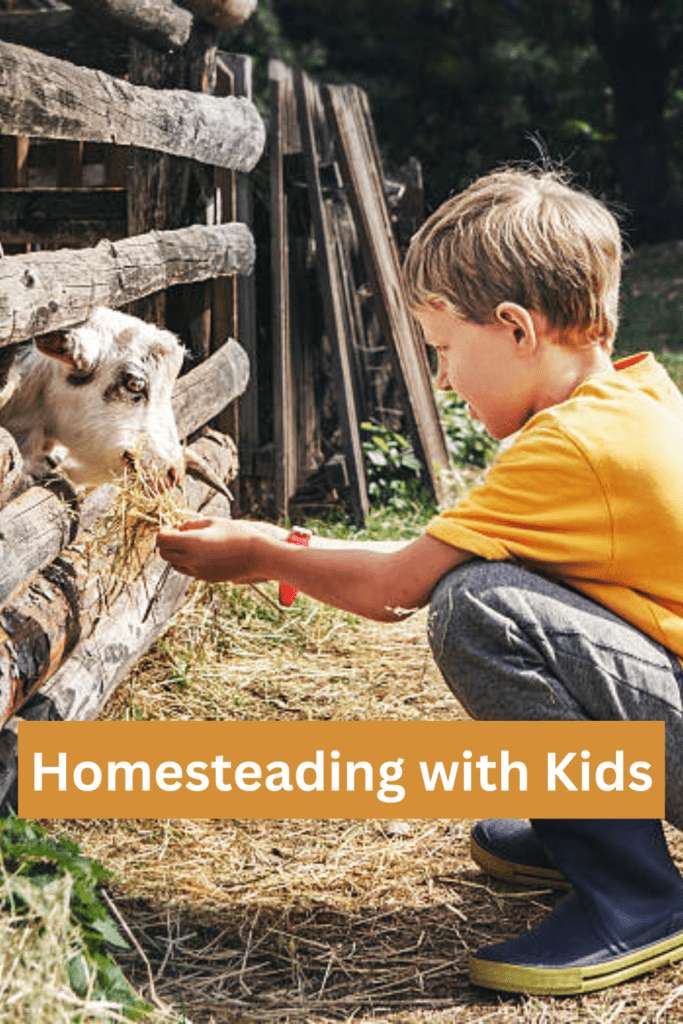
Involving children in animal care and husbandry is a wonderful way to teach responsibility, empathy, and the value of hard work. As someone who’s spent years tending to various animals on my childhood homestead, I can attest to the joy and learning opportunities that come with this aspect of homesteading.
Start by assigning age-appropriate tasks to your children. Even toddlers can help with simple chores like filling water bowls or scattering feed for chickens. As they grow older, their responsibilities can increase.
Here are some ideas for involving kids of different ages:
- Young children (3-6 years old): Collect eggs from chicken coops.
- Helping to brush gentle animals like rabbits or goats.
- Assisting with feeding smaller animals.
- Older children (7-12 years old): Cleaning animal enclosures.
- Helping with milking goats or cows.
- Assisting with grooming larger animals.
- Teenagers: Taking on full responsibility for certain animals.
- Helping with more complex tasks like hoof trimming or shearing.
- Assisting with breeding and birthing processes.
Teaching Animal Safety: Homesteading with Kids
It’s crucial to teach children about animal safety and proper handling techniques. Always supervise younger children around animals and demonstrate the correct way to approach and interact with each species. This not only ensures the safety of both the child and the animal but also instills a sense of respect for living creatures.
Encourage your children to observe and learn about animal behavior. This can be a great opportunity to teach them about life cycles, nutrition, and even basic veterinary care. Keep a journal or chart where kids can record daily observations, feeding schedules, and growth progress of the animals they’re caring for.
Don’t forget to make it fun! Turn chores into games or challenges. For example, see who can collect the most eggs in a set time or create a “Barn Olympics” with various animal care tasks as events. This not only makes the work more enjoyable but also builds a positive association with homesteading activities.
Celebrate your children’s efforts and achievements in animal care. Acknowledge their hard work and the improvements they make over time. This positive reinforcement will encourage them to continue taking an active role in homesteading and may even spark a lifelong passion for animal husbandry.
By involving your children in animal care, you’re not just teaching them practical skills – you’re nurturing a deep connection with nature and instilling values that will serve them well throughout their lives.
Teaching Sustainable Living Practices to Kids
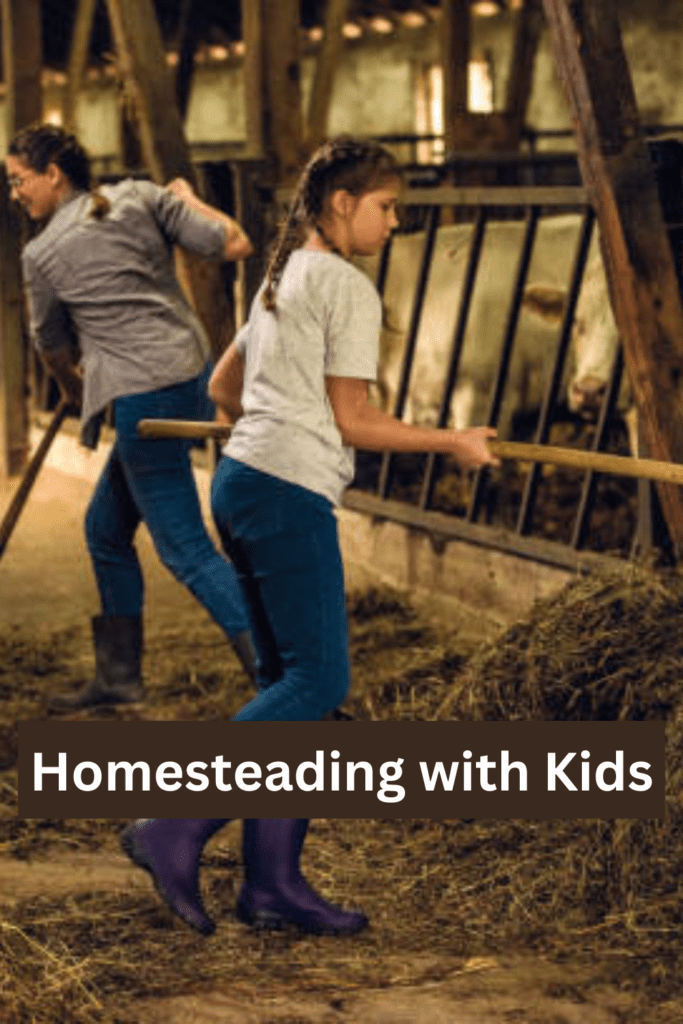
Teaching kids about sustainable living practices is not only beneficial for their future but also for the planet. As someone who’s embraced the off-grid lifestyle, I’ve found that involving children in these practices early on can instill valuable life skills and environmental awareness.
One of the most effective ways to teach sustainable living is through hands-on experiences. Get your kids involved in gardening by giving them their own small plot or container to care for. They’ll learn about the lifecycle of plants, the importance of water conservation, and the satisfaction of growing their own food. It’s amazing to see their faces light up when they harvest their first tomato or pick their own strawberries!
Composting Activities
Composting is another great way to teach kids about sustainability. Set up a compost bin in your backyard and show them how kitchen scraps and yard waste can be transformed into nutrient-rich soil for the garden. This practical lesson in recycling helps children understand the concept of “waste not, want not” and how nature’s cycles work.
Energy Consumption Activities
Energy conservation is an important aspect of sustainable living. Encourage your kids to be mindful of their energy use by turning off lights when leaving a room or unplugging electronics that aren’t in use. Make it a fun challenge by having them track the family’s energy consumption and brainstorm ways to reduce it.
Water Conservation Activities
Water conservation is equally crucial. Teach your children to turn off the tap while brushing their teeth, take shorter showers, and collect rainwater for watering plants. These simple habits can make a big difference in the long run.
Upcycling and Recycling Activities
Upcycling and repurposing are creative ways to teach kids about reducing waste. Encourage them to think of new uses for old items instead of throwing them away. This could be as simple as turning an empty jar into a pencil holder or using old clothes to make a patchwork quilt.
Lead by example. Children are more likely to adopt sustainable practices if they see their parents doing the same. Make sustainable choices in your daily life, from using reusable bags and water bottles to choosing eco-friendly products.
Remember, teaching sustainable living isn’t about perfection – it’s about progress. Every small step counts, and by involving your kids in these practices, you’re nurturing a generation that cares for the earth and understands the importance of living in harmony with nature. It’s a journey we’re all on together, and there’s no better time to start than now.
Incorporating Homesteading into Homeschooling
Homesteading and homeschooling go hand in hand, offering a unique opportunity to blend practical life skills with academic learning. I’ve found that incorporating homesteading activities into our homeschooling routine has been both rewarding and educational for the whole family.
One of the most effective ways to integrate homesteading into homeschooling is through project-based learning.
Gardening
For example, planning and maintaining a vegetable garden can teach children about biology, botany, and even math. They’ll learn about plant life cycles, soil composition, and how to calculate crop yields. Plus, there’s nothing quite like the pride of harvesting vegetables you’ve grown yourself!
Check out my article on the best gardening tools for kids.
5 Best Gardening Tools for Kids to Complete Chores
Animal Husbandry
Another great homesteading activity that doubles as a learning opportunity is animal husbandry. Raising chickens, for instance, can teach kids about responsibility, animal biology, and even basic economics if you decide to sell eggs. They’ll learn about feed ratios, egg production cycles, and how to care for living creatures.
Food Preservation
Food preservation is another valuable skill that ties into various subjects. Canning fruits and vegetables from your garden incorporates elements of chemistry, food safety, and even history. You can discuss how people preserved food before refrigeration and explore the science behind different preservation methods.
Construction Projects
For older children, construction projects around the homestead offer hands-on lessons in physics, geometry, and problem-solving. Building a rabbit hutch, chicken coop, or raised garden bed requires measuring, planning, and understanding basic structural principles.
Creative Arts
Don’t forget about the arts! Homesteading provides ample opportunities for creative expression. Encourage your children to keep nature journals, sketch plants and animals, or even write stories inspired by life on the homestead.
To make the most of these learning opportunities:
- Set clear learning objectives for each activity.
- Encourage questions and curiosity.
- Document progress through photos, videos, or journals.
- Relate homesteading activities to traditional subjects when possible.
- Allow for flexibility and follow your children’s interests.
Remember, the goal is to create a rich, immersive learning environment that prepares your children for life, not just tests. By integrating homesteading into your homeschooling curriculum, you’re teaching valuable skills while fostering a deep connection to the natural world and a sense of self-reliance that will serve them well throughout their lives.
Ensuring Safety and Age-Appropriate Tasks
When it comes to homesteading with kids, safety should always be our top priority.
First and foremost, it’s crucial to assess each child’s abilities and maturity level before assigning tasks. What’s appropriate for a 10-year-old might be dangerous for a 5-year-old. Start by introducing simple, low-risk activities and gradually increasing complexity as they grow and demonstrate responsibility.
Here are some age-appropriate tasks to consider:
- Toddlers (2-3 years): Helping water plants, feeding small animals, or gathering eggs (with supervision).
- Preschoolers (4-5 years): Planting seeds, light weeding, or assisting with meal preparation.
- School-age children (6-12 years): Harvesting vegetables, caring for animals, or learning basic food preservation techniques.
- Teenagers: Operating small machinery, assisting with construction projects, or managing their own garden plots.
Remember, constant supervision is key, especially for younger children. Always be within earshot and sight of little ones as they explore and learn.
When it comes to tools and equipment, invest in child-sized versions whenever possible. This not only makes tasks more manageable for small hands but also reduces the risk of accidents. For older children using adult tools, provide thorough training and ensure they wear appropriate safety gear.
Creating a safe environment goes beyond just supervising activities. Take time to childproof your homestead:
- Secure fences and gates to prevent wandering.
- Store chemicals, tools, and dangerous items out of reach.
- Clearly mark off-limits areas.
- Establish and enforce safety rules.
One of the most effective ways to ensure safety is through education. Teach children about potential hazards, proper tool usage, and what to do in case of emergencies. Make it a fun learning experience by incorporating games or challenges that reinforce safety concepts.
Lastly, don’t forget about sun protection and hydration, especially during long days outdoors. Encourage regular breaks, provide plenty of water, and make sure everyone’s wearing sunscreen and appropriate clothing.
By prioritizing safety and matching tasks to each child’s abilities, we can create a nurturing environment where kids can learn, grow, and develop a deep appreciation for the homesteading lifestyle. It’s a journey that requires patience and vigilance, but the rewards of raising capable, self-reliant children are truly priceless.
Conclusion
Homesteading with kids is a rewarding journey that offers countless benefits for families. From cultivating a garden together to caring for animals and learning sustainable practices, involving children in homesteading activities creates a rich, hands-on learning environment. By preparing your homestead with kid-friendly spaces and ensuring age-appropriate tasks, you can create a safe and engaging experience for children of all ages.
Remember, homesteading is more than just a lifestyle; it’s an opportunity to instill valuable life skills, foster a connection with nature, and build lasting family memories. Whether you’re homeschooling or simply looking to spend more quality time together, homesteading provides endless possibilities for growth and learning.
So, roll up your sleeves, grab those tiny garden gloves, and begin on this amazing adventure with your little ones. As you watch your children grow alongside your homestead, you’ll discover that the seeds you plant today will bloom into a lifetime of self-sufficiency, resilience, and appreciation for the simple things in life!
Want more homesteading guides? Check out: The Real-Life Homesteading Guide: Expectations, Challenges, and How to Thrive
Resources: Here are some helpful resources for further information.
- Tips for Homesteading with Children – By Homesteading Family
- Homesteading with Kids: How We Do It – By The Prairie Homestead
- Homesteading Skills Young Children Love to Learn – By Salt in my Coffee
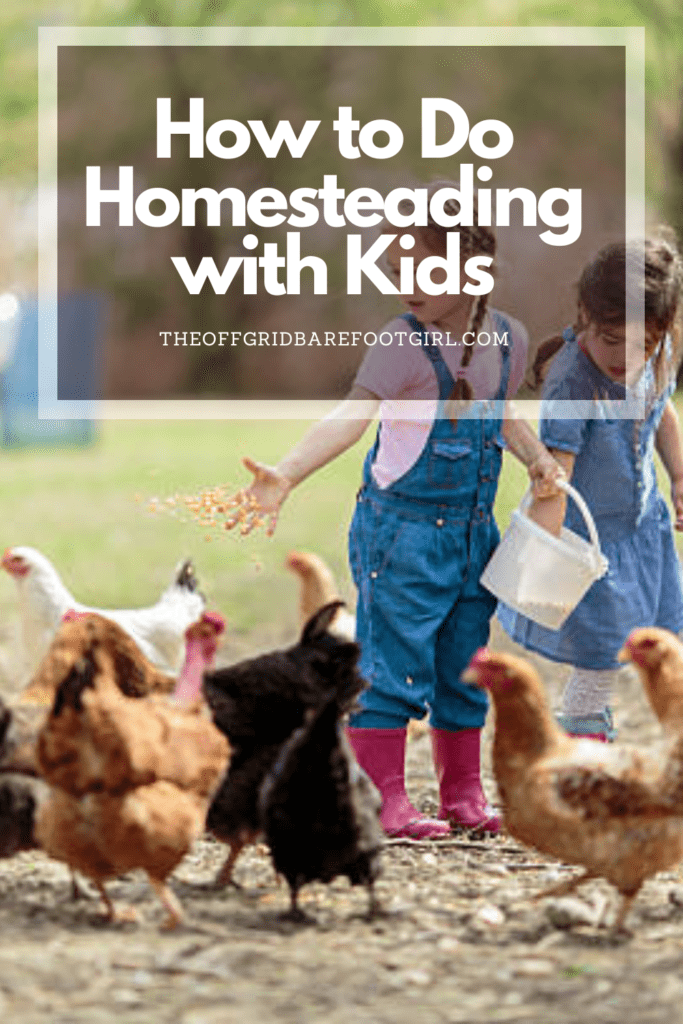
Frequently Asked Questions
1. What are some age-appropriate tasks for kids in homesteading?
Kids can help with various tasks based on their age. Younger children can assist with watering plants, gathering eggs, or feeding animals. Older kids can take on more responsibility, such as planting seeds, weeding, or even helping with basic maintenance around the homestead.
2. How can I teach my kids about gardening?
Start with simple gardening projects, like growing herbs or vegetables in containers. Involve them in the entire process—from choosing seeds to planting and harvesting. Use these activities to teach them about plant biology and the importance of healthy food.
3. What safety measures should I consider when involving kids in homesteading?
Always supervise young children, especially around tools and animals. Teach them safety rules for using gardening tools, handling livestock, and being aware of their surroundings. Ensure they wear appropriate clothing, such as gloves and closed-toe shoes, to protect them while working.
4. How can homesteading benefit my children’s development?
Homesteading teaches kids valuable life skills, such as responsibility, teamwork, and patience. It encourages them to appreciate nature, understand where their food comes from, and develop a strong work ethic. These experiences can foster independence and a sense of accomplishment.
Summary
I hope I have inspired you to plan a bugout bag with your kids with these tips and products.
If you were encouraged by this post, I invite you to check out my FREE Printables Page for fun free printables, planners, and charts.
ENTER MY FREE Printables Page HERE
Here are some more of my inspiration posts to check out!
How to Create the Ultimate Bugout Bag for Kids
How To Plan An Exciting Easter Egg Hunt In Your Spring Garden!
DIY Pop-Tart Gingerbread Houses: The Ultimate Holiday Activity for Kids
How to Have a Safe and Exciting Mountain Sledding Experience with Teens!
A-maze-ing Fun In a Corn Maze with Teens
17 Free Outdoor Summer Boredom Busters for Kids
Lake Fishing with Kids: What to Know Before You Go
Ultimate Guide on River Safety for Kids
Why Archery for Kids Teaches a Growth Mindset
Homeschooling Teens With Anxiety: How Easy It Can Improve Grades
5 Best Gardening Tools for Kids to Complete Chores
How to Open A Can of Food With Your Bare Hands
The Best Activities for First Aid for Kids
Knife Safety for Kids: Ultimate Guide to Their Safety
Blessings,
The Off Grid Barefoot Girl

